Skill Management Tool
The ready-to-use system of truth
The source of truth for skills in an organization is typically a centralized database that maintains an up-to-date and comprehensive repository of all skills relevant to the business. TalentGuard serves as the backbone for managing talent by offering a structured framework for skills across various roles, departments, and career paths. It ensures consistency, accuracy, and accessibility, acting as the definitive reference point for employees, managers, and HR teams. By keeping this database dynamic and continuously updated with new skills and evolving industry trends, organizations can effectively align workforce capabilities with their strategic goals, enabling better decision-making around talent development, succession planning, and workforce agility.
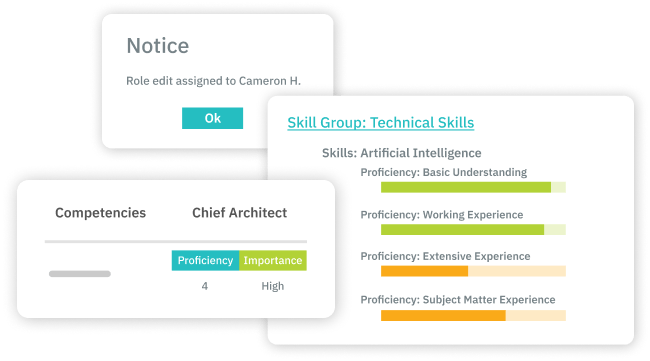
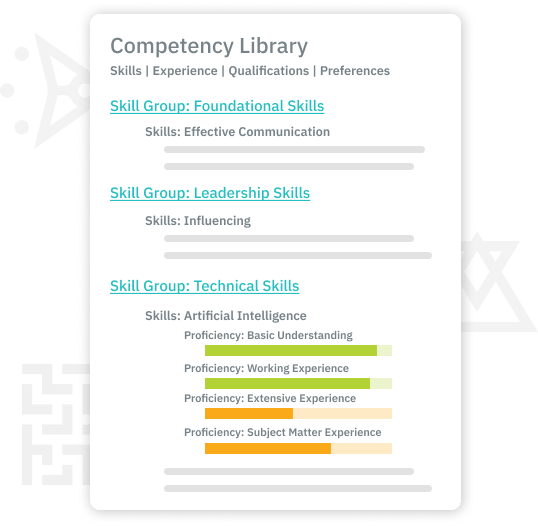
Create skills and competencies
TalentGuard’s platform provides the ability to create, edit, and compare multiple competencies essential for job functions, including skills, experiences, qualifications, and preferences. This functionality allows organizations to build comprehensive profiles for each role, ensuring that all critical aspects of a job are accurately captured. Users can customize these competencies to align with evolving business needs and industry standards. Additionally, the platform offers a comparison feature that enables side-by-side analysis of different competencies, making it easier to identify gaps or overlaps across roles. This flexibility ensures that organizations can maintain up-to-date and relevant job functions, fostering a more agile and responsive workforce.
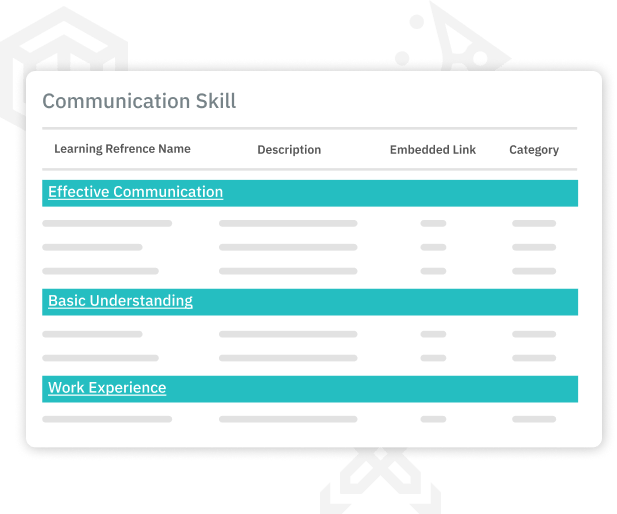
Map skills and competencies to jobs
We offer the ability to map competencies, job grades, learning resources, and other critical data to job profiles, creating a holistic view of each role within an organization. This mapping ensures that job profiles are not just limited to a list of tasks or responsibilities, but are enriched with the skills and qualifications required for success. By linking job grades, learning resources, and competencies, organizations can align employee development with career progression, making it easier to identify learning pathways, training needs, and advancement opportunities. This integrated approach allows companies to effectively manage talent, ensuring that employees have access to the resources and guidance they need to grow in their roles and advance within the organization.
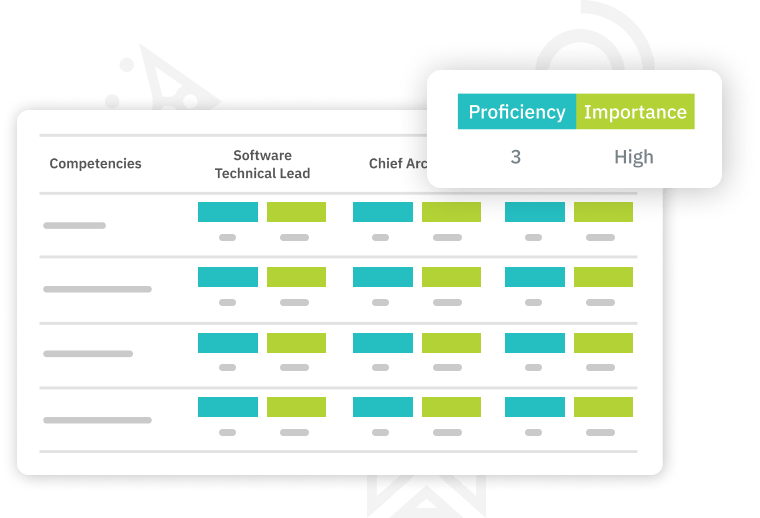
Calibrate jobs across job families
Job profile calibration involves fine-tuning the proficiency levels and importance of competencies tied to different job profiles and grade levels. This process ensures that each job profile accurately reflects the skills and expertise required for success at various levels within the organization. By adjusting these parameters, organizations can create clear distinctions between roles, making it easier to identify development gaps, ensure consistency across similar roles, and align performance expectations with job grades. This calibration also helps in establishing a fair and transparent system for evaluating employee performance and career progression, ensuring that competencies are weighted appropriately based on their relevance to each role.
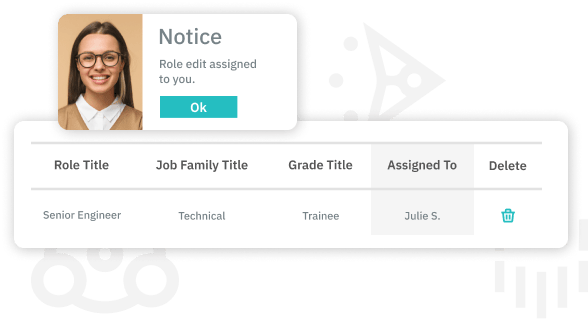
Govern job role data
We enable seamless governance of job role data by tracking job role history, ensuring that all changes and updates to roles are properly documented over time. This feature allows organizations to maintain a clear record of how roles have evolved, providing insights into adjustments in responsibilities, competencies, or job requirements. By keeping a detailed history, companies can make informed decisions when reprocessing roles, compare past and current job profiles, and ensure alignment with organizational goals. This historical tracking also supports compliance and transparency, offering a reliable source of information for audits, workforce planning, and employee career development.
Get Your Free Demo & See our Platform in Action
Select from one of the bundles below and we will tailored the demo to your needs. Let us show you how TalentGuard’s solutions adapt to your industry.
Automate
Create skill profiles, create detailed job descriptions, align learning content with specific skills, and chart clear career path progressions to set the foundation for effective talent management.
Automate includes:
- Create Skill and Competency Profiles
- Develop Job Descriptions
- Map Learning to Skills and Competencies
- Map Career Path Progressions
Assess
Effectively assess their employees’ skills, identify gaps, and implement strategies to develop a skilled and competent workforce prepared to meet current and future challenges.
All the Automate features plus the ability to:
- Create a Skills Inventory
- Conduct Gap Analysis
Engage
Organizations can significantly enhance their talent development strategy and workforce effectiveness by assessing employee skills, curating personalized learning paths, recommending appropriate career paths, and tracking career goals.
All the Automate features plus the ability to:
- Assess Employee Skills and Competencies
- Curate Personalized Employee Learning Paths
- Recommend Employee Career Paths
- Track Career Goals
Optimize
Building talent pools, measuring employee performance, tracking certifications, and conducting multi-rater feedback enhance talent management, ensure compliance, and foster organizational leadership development.
All the Engage features plus the ability to:
- Build Talent Pools
- Measure Employee Performance
- Track Employee Certifications
- Conduct Multi-Rater Leadership Feedback
Trusted by:




Your workforce is changing. Never be unprepared again.
Read our eBook
Skill Management Tool
A skill management tool can help your organization understand where their employees are and what the core competencies are for individual employees. Management can also plan future progress with a clear view of the gaps they need to fill. When you’re looking for the best skills management software, it’s important to have a firm list of the specific things that you’re looking for in a program and a vendor.
Many companies will look for skills tracking software that offers employee skill management, skills mapping exercises, and robust reporting options to help human resources and management work to improve the process for employees and overall productivity. There are many choices in skills management software. Free options are available, and there are several options on the market in various price ranges to meet organization budgets. A skill management tool is designed to help your organization better define roles can be an excellent resource for managers looking to improve performance and add new talent.
Employee skill management solutions help you to see individual team members and give you an overview to clearly pinpoint where there are gaps that need to be filled. This can help with future training initiatives and to understand what qualifications should be prioritized in new and advancing staff members.
Talent Management System
Talent management software is more than a simple program to assess skills. Companies that use talent management software need a more robust solution. Often companies with a great many employees simply can’t organize efficiently without a good talent management system. The talent management tools included in a full management system can help you organize from recruitment all the way through the lifecycle of your employees. The talent management software market is growing at a rapid pace. Companies have found performance management software, talent acquisition software, and solutions to bridge all of the skills assessments necessary to run a productive team essential.
Talent management systems examples provide tools to help managers organize the entire lifecycle for their staff for growth and higher productivity. With robust tools and reporting options, HR can streamline the recruitment process to find the right talent for their open positions. Once employees join the team, the tools also help with development, training, and overall performance. When used effectively, your talent management system improves the work experience for your employees and propels the organization’s success.
Competency Matrix
A competency matrix is a fantastic tool to help your managers understand exactly what skills are present in the internal workforce. The employee skill matrix chart gives an overview of each employee and what skills they have. Why is this important? If you’re putting together a team for a specific project, the best skills matrix software can help you quickly assess what type of talent you have and what you might be missing.
To create a skills matrix template, you would first decide what the objectives of the project are and what competencies are needed to ensure success. The competency matrix software can be used for specific projects, to help you get an overview of your workforce, to hire for specific departments, or to gauge areas where your team may be lacking overall. You can use the matrix to help you find employees with particular experience such as a background with a programming language. You can also use the matrix to pinpoint soft skills, which can be integral to company success but may be overlooked when assessing job requirements.
Competency Mapping and Assessment
Competency mapping and assessment is an important process to help your leadership oversee and manage the most important asset any organization has – its employees. Competency mapping software can help your team develop the data and insights necessary to fill gaps and manage current talent. Using competency mapping tools and developing customizable competency mapping templates can help large organizations create a more accurate measurement of the talent they have internally.
The competency mapping examples allow you to better understand your key staff and pinpoint ways to drive progress, both for individuals and the company itself. A great company culture offers development opportunities that benefit the staff while strategically positioned to help with company goals. A great competency mapping software helps your staff automate this process, taking the guesswork out of assessments. Your organization gets a comprehensive understanding of the particular skills that each employee has and management can make new development opportunities available in a proactive way.
Competency Management Software
A good competency management system allows your leadership to automate the employee lifecycle to a great degree. What this means is that your competency management program provides robust information to help management create opportunities for staff while improving company performance. The market is saturated with competency management software – free, basic, and more advanced models are available for every type of organization and budget.
Your competency management system allows you to streamline the recruitment and onboarding process by organizing internal information and pinpointing the skillsets that are needed in a prioritized way. With access to robust reporting, HR and management can work more proactively with individual employees and build an exact overview of staff members to develop more productive teams.
Competency management is essential to prepare new employees for a successful transition into company culture. A great system can help you develop training initiatives that help your staff succeed, which in turn makes your organization stronger and more competitive. The tools available through a great software solution can help your staff oversee performance and performance reviews and provides a great marker to help staff and management correctly assess compensation packages and benefits. Whether you’re looking to fill gaps with new employees or interested in promoting employees from within, the data and analytics of a good system make your hiring choices precise and dependable.
